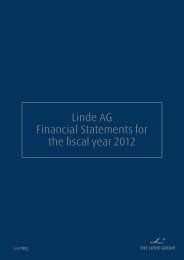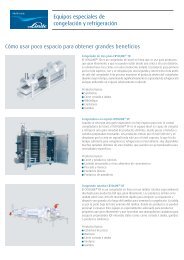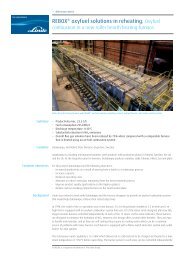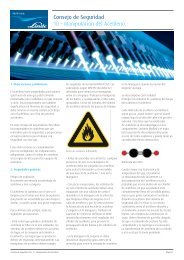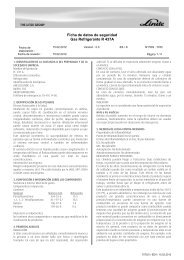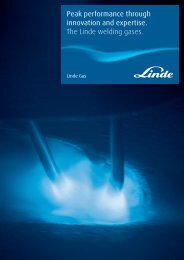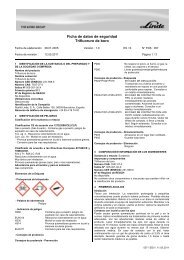Safety Advice. 21 â Storing gas cylinders.
Safety Advice. 21 â Storing gas cylinders.
Safety Advice. 21 â Storing gas cylinders.
Create successful ePaper yourself
Turn your PDF publications into a flip-book with our unique Google optimized e-Paper software.
<strong>Safety</strong> <strong>Advice</strong>.<strong>21</strong> – <strong>Storing</strong> <strong>gas</strong> <strong>cylinders</strong>.1. Area of applicationThe storage of <strong>gas</strong> <strong>cylinders</strong> (compressed<strong>gas</strong> containers) is covered by the technicalregulations on compressed <strong>gas</strong>es (TRG280).Listed below are some of the most importantrequirements concerning the erectionof small <strong>gas</strong> stores (maximum 50 <strong>cylinders</strong>)for inert, fire-stimulating and flammable<strong>gas</strong>es (e.g. argon, oxygen, acetylene,propane).2. Gas cylinder storesA <strong>gas</strong> cylinder store is a defined placewhere full <strong>gas</strong> <strong>cylinders</strong> are continuouslykept in stock and empty <strong>gas</strong> <strong>cylinders</strong> arestored until they are removed.3. General requirements• Store staff should regularly receive instructionin the handling of <strong>gas</strong> <strong>cylinders</strong>and on operating instructions in accordancewith regulations on hazardoussubstances.• Signs should be mounted forbiddingaccess for unauthorized persons, e.g.• There should be no risks from vehicles(e.g. collision protection).Store for <strong>gas</strong> receptaclesNo smoking, fire or open lights.No access for authorized persons.• The <strong>gas</strong> <strong>cylinders</strong> must stand securelyon flat ground and should be protectedfrom falling over, e.g. storage in pallets,erection in groups.• The valves should be closed securelyand the cylinder caps should be screwedon.• A minimum distance of 0.5 m shouldbe maintained between containers andsources of heat or radiators.• A fire extinguisher and a telephone withinformation on emergency telephonenumbers should be easily accessible.• Stores should not be set up in criticalareas such as stairways, corridors, emergencyroutes, garages or passages forpersons or vehicles.• Special regulations (TRG 280) should beobserved in the case of undergroundstorage rooms.• Protective areas (see 6 below) must bemaintained in the case of flammable<strong>gas</strong>es.• Gas <strong>cylinders</strong> with liquid <strong>gas</strong> (e.g. propane,butane) should be stored upright.• Gas refilling and repair work on <strong>gas</strong><strong>cylinders</strong> are forbidden in stores.4. Stores in roomsStores in rooms are stores in closed roomsor in rooms that are open on one side (see5 below for exceptions).4.1. General requirements• The walls of neighbouring buildings andthe outside walls of the store must bebuilt to be fire-resistant at least. Theroofing must be sufficiently resistant toflying sparks and radiating heat.• The flooring must be hardly flammable.• In the store rooms there should be nopits, channels or drains to channelswithout liquid closuresand there should be no cellar accesses orother open passages to cellar rooms.Furthermore, there should be no cleaningor other openings of chimneys.• There should be adequate ventilation inthe store (ventilation area should be atleast 1% of the floor surface).• No other flammable substances (e.g.flammable liquids, wood, paper) shouldbe stored in the store rooms (exceptwhen separated by a protective wallwith a height > 2 m).• Store rooms in which more than 25 filled<strong>gas</strong> <strong>cylinders</strong> are stored should not besituated above or below rooms intendedfor continuous use by people.Caution: <strong>gas</strong> cylinder4.2. Requirements for flammable <strong>gas</strong>es• If the walls of a store room neighbour ona public path or road, these walls shouldhave neither doors nor windows belowa height of 2 m (except for self-closingand fire doors).• A distance of a minimum of 2 m must bemaintained between <strong>gas</strong> <strong>cylinders</strong> withoxidizing <strong>gas</strong>es and <strong>gas</strong> <strong>cylinders</strong> withflammable <strong>gas</strong>es.5. Stores in the openStores in the open are also stores that haveat least two sides open as well as storesthat are open on one side only if the depth– measured from the open side – is notgreater than the height of the open side.One side of the room is also defined asbeing open if it is made of wire grating orsimilar material.The safety distance to neighbouring equipmentwhich could be potentially dangerous<strong>Safety</strong> <strong>Advice</strong>. <strong>21</strong> – <strong>Storing</strong> <strong>gas</strong> <strong>cylinders</strong>. Page 1
(e.g. stores with flammable substances)is at least 5 m. A protective wall with aheight of 2 m and made of nonflammablebuilding material can be a substitute forthe safety distance.6. Protective area6.1. General requirements• The protective area and the risk ofexplosion must be indicated by warningsigns (see example of sign in 3 above).• There should be no sources of ignition inthe protective area.• Electrical equipment must have zone 2explosion protection.• Only those vehicles necessary to servethe store are permitted.• The protective area should not extend toneighbouring buildings or public paths orroads.6.2. Requirements for stores in roomsThe entire room is a protective area in thecase of rooms with a surface area of up to20 m 2 .Gaseslighter than air heavier than airHeight h1 (m)Radius r1 (m)Bottle Cylinder Bottle Cylinder2 2 1 12 2 2 36.3. Requirements for stores in the open• The protective area may be enclosed onmax. two sides by min. 2 m high protectivewalls without openings and madeof nonflammable building material. Onone side this wall may also be the wallof a building, which must not have anyopenings in the protective area.• In the store rooms there should be nopits, channels or drains to channels withoutliquid closures and there should beno cellar accesses or other open passagesto cellar rooms. Furthermore, thereshould be no cleaning or other openingsof chimneys.hrhlighter than air6.4. Dimensions of the protective areasrheavier than airFor flammable <strong>gas</strong>es that are heavier thanair (e.g. propane, butane).For flammable <strong>gas</strong>es that are lighter thanair (e.g. acetylene, methane, hydrogen).Linde AGLinde Gas Division, Linde Gas Germany, Seitnerstraße 70, 82049 PullachPhone 018 03.85 000-0*, Fax 018 03.85 000- 1, www.linde-<strong>gas</strong>.com<strong>Safety</strong> <strong>Advice</strong>. <strong>21</strong> – <strong>Storing</strong> <strong>gas</strong> <strong>cylinders</strong>. Page 2




